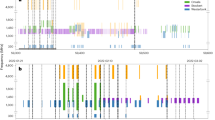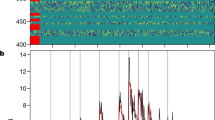Abstract
THE 10.7 cm index of solar activity has been used for many studies of solar–terrestrial interactions. The principal reason for this is that highly accurate data extending back to 1947 are available. The present availability of accurate information at other microwave frequencies makes it possible to determine the relative effectiveness of these frequencies as indices of solar–terrestrial relations.
This is a preview of subscription content, access via your institution
Access options
Subscribe to this journal
Receive 51 print issues and online access
$199.00 per year
only $3.90 per issue
Buy this article
- Purchase on Springer Link
- Instant access to full article PDF
Prices may be subject to local taxes which are calculated during checkout
Similar content being viewed by others
References
Basu, S., and Karmakar, S., J. Geophys. Res., 72, 1901 (1967).
Solar Radio Flux Meas. Sagamore Hill Radio Obs., Air Force Cambridge Research Laboratories (1966).
Mon. Bull. Solar Geophys. Data, IER-FB-270 to, 281 (Feb. 1966 to Jan. 1967). (Environmental Science Service Administration.)
Kundu, M. L., in Solar Radio Astronomy, 229 (John Wiley and Sons, New York, 1965).
Kundu, M. R., in Proc. Amer. Astro. Soc.-NASA Symp. Phys. Solar Flares, 1963, 335
Author information
Authors and Affiliations
Rights and permissions
About this article
Cite this article
CASTELLI, J., STRAUSS, F. Correlation between Sudden Cosmic Noise Absorption and Solar Radio Bursts observed at Five Microwave Frequencies. Nature 216, 776–777 (1967). https://doi.org/10.1038/216776a0
Received:
Issue Date:
DOI: https://doi.org/10.1038/216776a0
This article is cited by
-
On the relationships between sfe (crochet) and solar X-ray and microwave bursts
Solar Physics (1975)
Comments
By submitting a comment you agree to abide by our Terms and Community Guidelines. If you find something abusive or that does not comply with our terms or guidelines please flag it as inappropriate.



